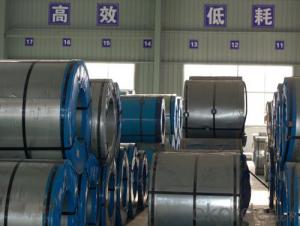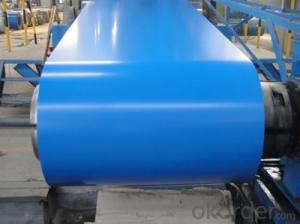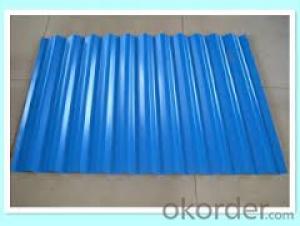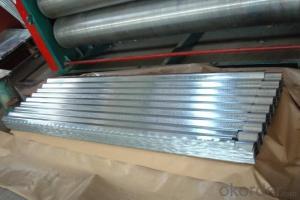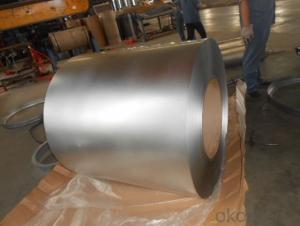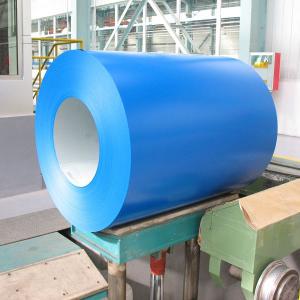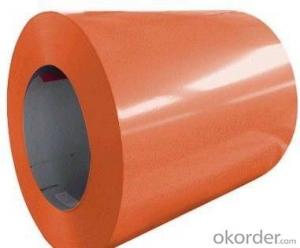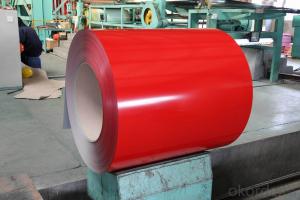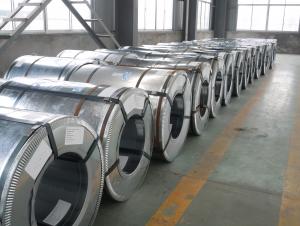Prepainted Aluzinc Steel in coil High Quality
- Loading Port:
- Shanghai
- Payment Terms:
- TT OR LC
- Min Order Qty:
- 50 m.t.
- Supply Capability:
- 80000 m.t./month
OKorder Service Pledge
OKorder Financial Service
You Might Also Like
Product Description:
Product Description:
Specification
1. Thickness: 0.3-0.8mm
2. Width: 914-1250mm
3. Inner Diameter: 508mm
4. Weight of Steel Coil: 3-15MT
5. Available Dipped Layer: 50-150g/m2
6. Surface Texture: Normal Coated
7. Type of coating structure: 2/1 Coat the top surface of the steel sheet twice, coat the bottom surface once, and bake the sheet twice.
8. Front Side Paint Thickness: 15-20μm (bottom paint+top paint)
9. Back Side Paint Thickness: 5-10μm
Mechanical Properties
1. Mechanical properties of base metals
Grade | Tensile Test | ||
Yield Strength MPa | Tensile Strength MPa | Elongation A80mm % ≥ | |
DC51D+Z | 140-350 | 270-500 | 22 |
DC52D+Z | 140-300 | 270-420 | 26 |
DC53D+Z | 140-300 | 270-380 | 30 |
2. Common performance of front coating
(1). Thickness: ≥20μm
(2). Pencil Hardness: 2H
(3). 60° specular glossiness of coating: >60
(4). 180°bend: ≤3T
(5). Impact: ≥9J
(6). Salt Fog Resistant: ≥500h
(7). Color difference:<3δe< p="">
- Q: I would like to know if steel is basically a very dense crystal, or if it is a different atomic structure
- Steel is made of billions, trillions of very small crystals. This is true of most metals. In order to see the crystal structure of steel, you usually need to cut a sample of it, grind and polish the cut face smooth, then etch the steel with a mixture of nitric acid and alcohol. Without polishing and etching the crystals aren't visible- it just looks like smooth solid metal. Also, in most cases the crystals are small enough that you need a microscope to see them clearly after etching.
- Q: What are the dimensions of a typical steel coil?
- The dimensions of a typical steel coil vary based on its intended use and manufacturer. However, a common range for the inner diameter is between 508 to 610 millimeters (20 to 24 inches), while the outer diameter can range from 1,200 to 2,000 millimeters (47 to 79 inches). The width of a steel coil can range from around 600 to 2,000 millimeters (24 to 79 inches), and the weight can vary from a few hundred kilograms to several metric tons.
- Q: When i was 15 i got caught steeling at Super A yes i know i cant believe it. They didnt call the cops or anything they released me to my aunt they took my name and adress and everythimg they said it wouldnt be on my record. But I'm not so sure. Will it be on my record if they didn't call the cops?i live in california. Is there any way i can check my record?
- Steeling? What's that? Did you take a piece of steel and weld it? I am confused?
- Q: What is the difference between steel coils and steel sheets?
- Steel coils and steel sheets are both forms of steel, but they have distinct differences. Steel coils refer to a long, continuous roll of steel that is wound up into a coil shape. These coils are usually produced at a steel mill and are typically used for further processing or manufacturing purposes. Steel coils are commonly used in various industries such as automotive, construction, and appliance manufacturing. They are often used to produce different products like pipes, tubes, and automotive parts. On the other hand, steel sheets are flat pieces of steel that are typically cut from steel coils. These sheets are available in various sizes and thicknesses, making them versatile for different applications. Steel sheets are commonly used in construction projects, such as roofing, siding, and structural components. They are also used in manufacturing processes, such as stamping, forming, and fabrication of various products. One key difference between steel coils and steel sheets is their shape and form. Steel coils are in a rolled, cylindrical form, while steel sheets are in a flat, rectangular shape. This difference in shape makes steel coils more suitable for continuous production processes, while steel sheets are used for specific applications that require flat surfaces. Another difference is the handling and transportation of these steel forms. Steel coils are typically transported and stored using special equipment, such as coil cars or cranes, due to their large size and weight. Steel sheets, on the other hand, can be easily stacked, transported, and stored using conventional methods. Lastly, the processing requirements of steel coils and steel sheets differ. Steel coils often undergo additional processing steps, such as slitting, cutting, or coating, to meet specific customer requirements. Steel sheets, on the other hand, may require minimal processing before being used in their intended applications. In summary, steel coils and steel sheets differ in their shape, handling, transportation, and processing requirements. Steel coils are rolled, cylindrical forms used for further processing, while steel sheets are flat pieces cut from coils and used for specific applications. Understanding these differences is crucial in selecting the appropriate steel form for a particular project or manufacturing process.
- Q: What are the main challenges in handling and processing steel coils?
- The main challenges in handling and processing steel coils include their large size and weight, which require specialized equipment and techniques for safe transportation and storage. Coils also tend to have sharp edges, posing a risk of injury. Additionally, maintaining the integrity and quality of the steel during processing can be challenging due to the potential for surface damage, rust, or deformation. Proper handling, storage, and processing techniques are crucial for minimizing these challenges and ensuring the efficient production of steel products.
- Q: What are the dimensions of steel coils used in shipbuilding?
- The dimensions of steel coils used in shipbuilding vary depending on the specific requirements of the ship being built. However, common dimensions for steel coils in shipbuilding typically range from 2-15 mm in thickness and 600-2000 mm in width.
- Q: How are steel coils inspected for surface defects after processing?
- Steel coils are inspected for surface defects after processing through a visual inspection process. Specially trained inspectors carefully examine the coils for any visible defects such as scratches, dents, or irregularities in the surface. They use advanced lighting techniques and magnification tools to ensure a thorough inspection. Additionally, automated systems may also be employed to detect and flag any defects that may have been missed during the visual inspection.
- Q: I do a lot of scrapping and would like to be able to separate stainless steel from regular steel. The magnet test doesn't always work since stainless can be magnetic, but what are some ways that I can for sure tell the difference? Or even something like a sound that they make that may help me to tell the difference.
- Stainless steel should be non-magnetic.
- Q: What are the different certifications required for steel coil manufacturers?
- Steel coil manufacturers may be required to obtain various certifications in order to operate in the industry, ensuring that they meet specific quality and safety standards. One widely recognized certification is the ISO 9001, an international standard for quality management systems. This certification demonstrates the manufacturer's commitment to consistently meeting customer and regulatory requirements through the implementation of effective processes and procedures. Another crucial certification is the ISO 14001, which focuses on environmental management systems. By obtaining this certification, manufacturers prove their dedication to implementing sustainable practices and minimizing their environmental impact. In terms of safety, manufacturers may need certifications like the OHSAS 18001 or ISO 45001, which are standards for occupational health and safety management systems. These certifications guarantee that the manufacturer has established proper processes and controls to ensure the well-being of their employees and stakeholders. Additionally, manufacturers may require industry-specific certifications such as the American Institute of Steel Construction (AISC) certification, which is specific to structural steel fabrication and erection. This certification ensures that the manufacturer adheres to the best practices in the industry. Furthermore, manufacturers may need certifications related to specific product standards, such as the American Society for Testing and Materials (ASTM) certification. This certification guarantees that the manufacturer's products meet specific quality and performance requirements. Acquiring these certifications is crucial for steel coil manufacturers as they provide customers with confidence in the quality, environmental responsibility, and adherence to industry standards of their products.
- Q: How are steel coils protected from corrosion?
- Steel coils are protected from corrosion through a variety of methods, including applying a protective coating such as zinc or polymer, using corrosion inhibitors, storing the coils in a controlled environment with proper ventilation and humidity control, and implementing regular inspection and maintenance practices to identify and address any potential corrosion issues promptly.
Send your message to us
Prepainted Aluzinc Steel in coil High Quality
- Loading Port:
- Shanghai
- Payment Terms:
- TT OR LC
- Min Order Qty:
- 50 m.t.
- Supply Capability:
- 80000 m.t./month
OKorder Service Pledge
OKorder Financial Service
Similar products
Hot products
Hot Searches
Related keywords
